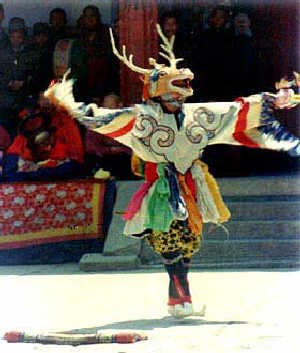 Tibetan Dance
Tibetan Dance
 Tibet, the ridge of the world, is also famously known as the "Ocean of Songs and Dances." Nearly every Tibetan can sing and dance. They sing anytime for any event and dance at festivals, weddings, and gatherings as well as during their spare time. A history of over several thousand years has witnessed the development of many kinds of folk dances in Tibet, including the religious dance called "Qamo."
Tibet, the ridge of the world, is also famously known as the "Ocean of Songs and Dances." Nearly every Tibetan can sing and dance. They sing anytime for any event and dance at festivals, weddings, and gatherings as well as during their spare time. A history of over several thousand years has witnessed the development of many kinds of folk dances in Tibet, including the religious dance called "Qamo."
The areas inhabited by Tibetans boasts a great diversity of folk songs and dances. Here, you will be introduce to some of the major dances popular with Tibetans:
 Guoxie dance
Guoxie dance
Guoxie (meaning "village" in Tibetan) is a group dance popular in rural areas of Tibet. The participants dance hand in hand and sing in rotation. The dance is often seen in villages and on open squares and threshing grounds. The dancers mark the rhythm by stamping their feet.
At festivals men and women stand hand in hand in two lines around a big vat of highland-barley wine placed on open ground. The two groups first sing and walk from left to right in a circle. When they finish singing, the xieben, or organizer of the dance, leads in shouting, "Xiu, xiu, xiu, xiu," and starts the dance with rhythmic steps. This rhythmic shouting is called xiege in Tibetan, or "beginning of the song," which is followed closely by quick-tempo singing and dancing.
The two lines of men and women compete in their dancing. After repeated dancing, the xieben leads in shouting, "Xiu, xiu, xiu, xiu," or sings alone while the others dance to his tempo. This part of the dance is called the xiexiu, or the finale.
 Duixie dance
Duixie dance
Duixie has two meanings. Dui means "upper" or "highland." Therefore it refers to the round dance popular in rural areas of Ngamring, Dingri, Lhaze, and Sagya counties. It also refers to the tap dance performed by urban people after the folk dance in dui areas was introduced intoLhasa.
In the mid-seventeenth century the fifth Dalai, in an effort to reinforce his rule by combining government with religion, stipulated that the Sholdon Festival be held in Lhasa from the end of June to early July every year. (The Sholdon Festival later developed into the Tibetan drama festival.) On this day groups from all parts of Tibet converged on Lhasa to perform. A group from a dui area in Tibet performed a lively and vigorous tap dance that was immediately loved and improved on by people in Lhasa. The major improvement was to start on the second beat, followed by a change of step after every three steps.
The dancers tap vigorously to music played on flutes, Chinese plucked stringed instruments, plucked six-stringed instruments, dulcimers, and clusters of small bells. The music for accompaniment of duixie has been formalized into a slow opening, short interlude, allegro, and finale. Thus duixie has gradually been transformed from a recreational dance to stage exhibition.
